Click on images to enlarge

infestation (Photo: Russell Graham)
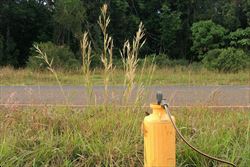
habit of a young flowering plant (Photo: Cook Shire Council)

habit of a mature flowering plant (Photo: Chris Gardiner)
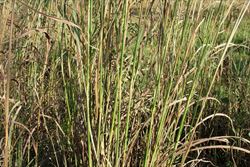
stems and older leaves (Photo: Cook Shire Council)

leaves (Photo: Russell Graham)
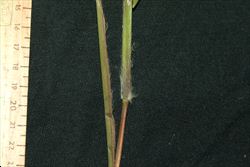
close-up of stem and leaf sheaths (Photo: Cook Shire Council)
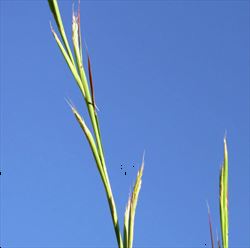
young seed-head beginning to open (Photo: Chris Gardiner)
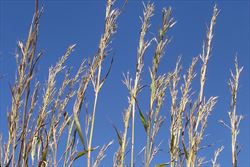
mature seed-heads (Photo: Chris Gardiner)
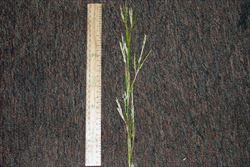
immature seed-head (Photo: Cook Shire Council)
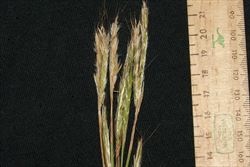
close-up of seed-head branches (Photo: Cook Shire Council)
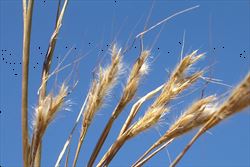
mature flower spikelets (Photo: Chris Gardiner)
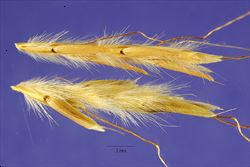
close-up of mature flower spikelets (Photo: Jose Hernandez at USDA PLANTS Database)
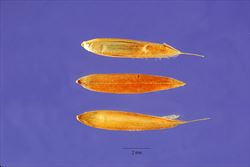
close-up of de-husked seeds (Photo: Jose Hernandez at USDA PLANTS Database)
Scientific Name
Andropogon gayanus Kunth
Family
Gramineae (South Australia)Poaceae (Queensland, New South Wales, the ACT, Victoria, Tasmania, Western Australia and the Northern Territory)
Common Names
bluestern, gamba grass, Rhodesian andropogon, Rhodesian bluegrass, tambuki grass
Origin
Native to most of sub-Saharan Africa (i.e. Sudan, Tanzania, Uganda, Cameroon, Central African Republic, Zaire, Benin, Burkina Faso, Ivory Coast, Gambia, Ghana, Guinea, Guinea-Bissau, Liberia, Mali, Mauritania, Nigeria, Senegal, Togo, Malawi, Mozambique, Zimbabwe, Botswana, Namibia, Swaziland and parts of South Africa).
Cultivation
Gamba grass (Andropogon gayanus) is commonly cultivated in northern Australia as a high yielding pasture grass. The cultivar 'Kent' is the only one that is widely sold and grown for this purpose.
Naturalised Distribution
Gamba grass (Andropogon gayanus) is becoming widely naturalised in northern Australia. It is currently found in the coastal districts of northern and north-western Western Australia, in the northern parts of the Northern Territory, and in northern Queensland. In Western Australia it is mainly found in the Kimberley region, though there are also records from the Pilbara region. It is most widespread in the Northern Territory, where large infestations are present in the Darwin-Kakadu region and it is also spreading rapidly in the Arnhem region. The majority of infestations in Queensland are from the far north of the state (i.e. in the Cook pastoral district), however specimens have been recently collected near Townsville (i.e. in the North Kennedy pastoral district).
It has also become naturalised in parts of South America (i.e. Brazil and Venezuela).
Habitat
This grass prefers lowland areas in regions with tropical and warmer sub-tropical climates. It forms robust stands in disturbed sites, overgrazed pastures, native grasslands, savannahs and other open woodland habitats in northern Australia. Gamba grass (Andropogon gayanus) can also invade a variety of other natural habitats from wetland margins through to upland savanna and is also particularly abundant along the banks of watercourses and along roadsides.
Habit
A very large, long-lived (i.e. perennial) grass usually growing 1.5-2.5 m tall but occasionally reaching up to 4 m in height. It forms large, dense, tussocks up to 1 m across.
Distinguishing Features
- a large, long-lived, grass reaching up to 4 m in height and forming dense tussocks up to 1 m across.
- its stems are usually quite robust and are often quite hairy.
- its large and elongated leaves (up to 1 m long and 1.5-5 cm wide) have a prominent central vein.
- its seed-heads are large branched, leafy, panicles that consist of numerous pairs of elongated flower clusters (4-9 cm long).
- its 'seeds' (7-9 mm long) are quite hairy and have a large, bent and twisted, awn (1-4 cm long).
Stems and Leaves
Plants can have few or many upright flowering stems (i.e. erect culms), which can vary from being quite robust to relatively fine and slender. These upright stems are quite hairy (i.e. pubescent) and arise from short creeping underground stems (i.e. rhizomes). The creeping underground stems (i.e. rhizomes) have very short internodes and branch readily.
The leaves consist of a leaf sheath, which partially encloses the stem, and a very large leaf blade (up to 1 m long and 1.5-5 cm wide). The leaf sheath is hairy (i.e. pubescent), especially when young, while the elongated (i.e. linear) leaf blades may be hairless (i.e. glabrous) or hairy (i.e. pubescent) on both surfaces. The leaf blades have a prominent central vein (i.e. midrib), entire margins, and come to a pointed tip (i.e. acute apex). Where the leaf sheath meets the leaf blade there is a small membranous structure (i.e. ligule).
Flowers and Fruit
The seed-head is a large leafy compound cluster (i.e. synflorescence) with up to six groups of branches, with 2-18 branches in each group. These branches (5-8 cm long) are very slender (i.e. filiform) and end in a pair of elongated flower clusters (i.e. racemes). Leafy bracts (i.e. spatheoles) 6-8 cm long are present at the base of these branches. The elongated flower clusters (4-9 cm long) have about 10-14 joints, each bearing a pair of very hairy flower spikelets. One of the flower spikelets in each pair is stalkless (i.e. sessile), while the other is borne on a stalk (i.e. pedicel) about 4-5 mm long. The stalkless or sessile spikelet (7-9 mm long) has both male and female parts (i.e. it is bisexual) and has a large, bent and twisted, awn (1-4 cm long). The stalked or pedicellate spikelet (5-8 mm long) only has male parts does not produce seeds (i.e. it is unisexual and sterile). It usually has a much smaller awn (1-10 mm long) that is relatively straight. Flowering and fruiting occurs mainly during autumn and winter (i.e. from April to August).
The flower spikelets are shed from the plant intact, along with their awns, and are usually referred to as 'seeds'. They actually consist of a 'seed' (i.e. caryopsis or grain), which is enclosed in a pair of inner floral bracts (i.e. a palea and lemma) and outer bracts (i.e. glumes). The 'seeds' (i.e. caryopses or grains) themselves are light brown to brownish-black in colour and only about 2-3 mm long by 1 mm wide.
Reproduction and Dispersal
Gamba grass (Andropogon gayanus) reproduces by seed. Because it was introduced as a commercial pasture plant, this species is most commonly spread to new areas as a consequence of being sold and deliberately planted for this purpose. Its transport as a fodder is another important means of dispersal to new areas.
Roadside slashing, machinery, vehicles and animals may also be vectors that disperse seeds shorter distances once it has become established in an area. Since the seeds of this species are light and fluffy they can also be spread short distances by wind and can float on water.
Environmental Impact
Gamba grass (Andropogon gayanus) is a serious threat to savannas of northern Australia and is regarded as an environmental weed in the northern parts of Western Australia, the Northern Territory and Queensland. It forms dense stands which out-compete native plants and is of most concern in savanna woodlands where rainfall is over 600 mm per annum. However, it is also regarded by many in the grazing industry to be a highly productive pasture grass, and is still widely grown for this purpose in northern Australia. It has a low palatability when mature and requires constant slashing or grazing to be of significant use in pastures.
In the Northern Territory, gamba grass (Andropogon gayanus) currently occurs in the Darwin, Palmerston and Litchfield Shires, the Coomalie Community Government, and the Mary River, Douglas River and Lower Daly River regions. It is spreading rapidly along roadsides and other disturbance corridors throughout the northern parts of the territory, and from these initial infestations it then invades relatively undisturbed vegetation, including significant conservation areas (e.g. Wildman River National Park and Kakadu National Park). In Queensland, the first naturalised specimen of gamba grass (Andropogon gayanus) was collected in 1992, from Bamaga on Cape York Peninsula. Since this collection was made, it has been found in sites to the north and south of Weipa, along the road to Hopevale in the Cooktown area, in the Lakeland Downs area, at Sudley to the east of Weipa, at Kalinga Station about 80 km north of Laura, on the Mitchell River near Kowanyama, at Kendell River west of Coen, at Batavia Downs, on aboriginal land in the Northern Peninsula Area (NPA) and near Mareeba. It has also been reported to be spreading into parks and reserves in northern Queensland (e.g. Heathland National Park and Keatings Lagoon Conservation Park). In Western Australia gamba grass (Andropogon gayanus) is currently mainly found in the area around Kununurra in the Kimberley region.
Compared with native grasses, gamba grass (Andropogon gayanus) forms much taller and denser stands of vegetation that dry out later in the season, and therefore invaded areas contain much higher fuel loads than native grasslands. Native grass fuel loads are typically 3-5 tonnes per hectare while gamba grass (Andropogon gayanus) fuel loads are typically 11 to 15 tonnes per hectare, and may sometimes be as high as 30 tonnes per hectare. These higher fuel loads support more frequent fires that are much more intense than those fuelled by native grasses, and the flame heights of fires in stands of gamba grass (Andropogon gayanus) fires are typically higher than the tree canopy. These hotter fires have the potential to severaly damage native plants and may also dramatically alter the structure of the native vegetation over time. In particular, the number of trees are reduced resulting in a change from native woodland into exotic grassland.
This is illustrated by the fact that gamba grass (Andropogon gayanus) invasion has been shown to produce a phenomenon known as a "grass-fire cycle" in northern Australia. This occurs when the amount of gamba grass (Andropogon gayanus) increases, causing an increase in the amount of fuel, which increases fire frequency and fire intensity. This then causes a decline in native tree and shrub cover, which aids further gamba grass (Andropogon gayanus) invasion and in this way a self-perpetuating cycle of invasion develops. For example, at one site in the Northern Territory, it was found that gamba grass (Andropogon gayanus) invasion had caused a 53% reduction in the native tree canopy in the last 12 years. If this sort of change occurs on a landscape scale, it could totally transform northern Australia's savannas from wildlife-rich woodlands into biologically impoverished monocultures of gamba grass (Andropogon gayanus) carrying regular hot fires. Because of this, invasion of gamba grass (Andropogon gayanus) in northern Australia has been nominated for listing as a "key threatenening process" under the Environment Protection and Biodiversity Conservation Act.
Gamba grass (Andropogon gayanus) invasion has also been shown to have a variety of other impacts on native flora and fauna, and even ecosystem function. For example, invaded areas generally have about half the number of plant species as native grassland areas. Its higher biomass also alters the structure of invaded areas and can change ecosystem processes such as nutrient cycling and water cycling. Daily water use in the wet season is three times higher in gamba grass (Andropogon gayanus) invaded sites than it is in nearby native grasslands, and this reduces the drainage of water through the soil profile.
Though gamba grass (Andropogon gayanus) invades and establishes more easily with disturbance, it can grow quite readily in burnt and unburnt savanna habitats regardless of whether the soil surface is broken. It is also not restricted to savannas, as it has been reported to invade upland melaleuca forests, riparian areas, and wetland and floodplain margins in northern Australia.
As well as affecting ecosystems, and the native flora and fauna in general, gamba grass (Andropogon gayanus) is also a significant threat to numerous rare and endangered native plants and animals. Its impact on the following species in the Northern Territory has been documented:
- the endangered Atlas moth (Attacus wardi). This species is found only in the Darwin region, where its larvae survive in remnant grasslands. Invasion of gamba grass (Andropogon gayanus) is a threat because in displaces the native food plants of this species and fuels hotter fires which destroy its habitat.
- the vulnerable Cycas armstrongii. This species is endemic to the north-western corner of the Northern Territory. While it is locally common, inappropriate fire regimes caused by the invasion of gamba grass (Andropogon gayanus) and other exotic grasses is a major threat. Mortality in excess of 50% of adult stems per fire event have been recorded when subject to fuel loads of 20 tonnes per hectare.
- the threatened Darwin palm (Ptychosperma bleeseri). The Darwin palm is only found in eight small rainforest patches east of Darwin, within the Adelaide and Howard River system. It is highly susceptible to the impacts of the spread of gamba grass (Andropogon gayanus) and associated changes to fire regimes.
- the vulnerable yellow-snouted ground gecko (Diplodactylus occultus). This species appears to be restricted to lowland open forests in the Mary, Wildman and West Alligator catchments in the Northern Territory. Its habitat is prone to wildfire and is threatened by invasion of exotic pasture grasses, particularly gamba grass (Andropogon gayanus) and mission grass (Pennisetum polystachyon), which are increasing fire intensities.
- the vulnerable eastern partridge pigeon (Geophaps smithii smithii). The most important threats to this species are the inter-related changes in grass composition and fire regimes caused by exotic grasses, including gamba grass (Andropogon gayanus), which will affect the diversity, timing and abundance of seeds available as a food source.
- the endangered yellow chat (Epthianura crocea tunneyi). A major factor contributing to the decline of this species are the changes to its habitat brought about by the widespread infestation of gamba grass (Andropogon gayanus) and other weed species in the floodplain habitats that it currently occupies.
- the endangered Helicteres sp. Glenluckie Creek. This undescribed species is only known from three populations in savanna woodlands near Darwin. It may be susceptible to invasion from perennial weedy grasses such as gamba grass (Andropogon gayanus), which are likely to smother individuals, alter fire intensity and/or frequency, and affect recruitment.
Other Impacts
As this species can greatly increase the frequency and intensity of wildfires, it may cause increased property losses to fire and even be a danger to human lives.
Legislation
This species is declared under legislation in the following states and territories:
- Queensland: Class 2 - landowners must take all reasonable
steps to keep land free of this species (throughout the entire state). It is
also illegal to sell a declared plant or its seed in this state.
- Western Australia: P1 - trade, sale or movement into the state prevented, and P2 - to be eradicated (throughout the entire state).
It is also currently being considered for declaration in the Northern Territory and Queensland.
Similar Species
Gamba grass (Andropogon gayanus) can usually be distinguished by its size, but is otherwise relatively similar to thatch grass (Hyparrhenia rufa). These two species can be distinguished by the following differences:
- gamba grass (Andropogon gayanus) is a very robust grass growing up to 4 m tall. Its paired flower clusters (i.e. racemes) are 4-9 cm long and each has 10-14 pairs of flower spikelets.
- thatch grass (Hyparrhenia rufa) is a robust grass growing up to 2.5 m tall. Its paired flower clusters (i.e. racemes) are 1.5-5 cm long and each has only 4-10 pairs of flower spikelets.

